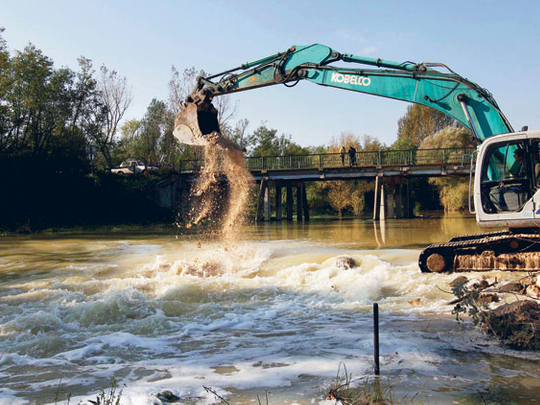
Kolontar, Hungary: The mighty River Danube was apparently absorbing the toxic red sludge with little immediate harm, officials reported yesterday — even though the amount of caustic slurry spewed over western Hungary was nearly as great as the Gulf of Mexico oil spill.
Revising even higher earlier estimates, government officials said the reservoir break on Monday dumped 600,000 to 700,000 cubic metres (158 million to 184 million gallons) of sludge onto three villages — just barely less in a few hours than the 200 million gallons the blown-out BP oil well gushed into the Gulf over the course of several months starting in April.
Officials with Hungary's national disaster relief service, meanwhile, said that a fifth person an 81-year-old man — died yesterday morning from unspecified injuries sustained in the flooding
The red sludge entered the Danube on Thursday and was moving downstream yesterday toward Hungary's immediate neighbours, Croatia, Serbia and Romania, amid fears that it will kill off the river's fish and plant life.
Measuring damage
Monitors were taking samples every few hours yesterday to measure damage from the spill but there were no reports of major harm to the waterway's ecosystem.
While Hungarian creeks and rivers near the collapsed reservoir have been devastated by the red sludge, the Danube, Europe's second largest river, appeared to be absorbing the blow due to its huge volume of water.
The pH level of the water where the slurry entered the Danube was 9 — well below the 13.5 measured in local waterways hit Monday by the toxic torrent, Hungarian rescue agency spokesman Tibor Dobson told the state MTI news agency yesterday.
Dobson added that such amounts posed no damage to the environment.
A neutral pH level for water is 7, with normal readings ranging from 6.5 to 8.5. Each pH number is 10 times the previous level, so a pH of 13 is 1,000 times more alkaline than a pH of 10.
Emergency crews, meanwhile, drained a second industrial reservoir at Hungary's red sludge site yesterday to prevent a new disaster.
Dobson told MTI that 100,000 cubic meters of fluid from a storage pond close to the burst reservoir was being gradually released into a local river already declared dead in the wake of Monday's environmental catastrophe. Gypsum was being dropped into the Marcal River from helicopters to neutralize the alkaline effect of the fluid, he said.
Conflicting information swirled about the dangers posed by the ankle-deep muck coating the most seriously hit areas after the collapse of a waste-storage reservoir at an alumina plant.
The Hungarian Academy of Sciences said while the material was a continued hazard, its heavy metal concentrations were not considered dangerous to the environment.
"The academy can say whatever it wants," fumed Barbara Szalai Szita, who lives in Devecser, one of the hardest-hit villages. "All I know is that if I spend 30 minutes outside I get a foul taste in my mouth and my tongue feels strange."
Carcinogenic metals
Hungary's environment minister, Zoltan Illes, said the henna-coloured sludge covering a ‘ 41-square-kilometre swathe of countryside does have "a high content of heavy metals," some of which can cause cancer. He warned of possible environmental hazards, particularly to groundwater systems.
With rain giving way to dry, warmer weather over the past two days, the caustic mud is increasingly turning to airborne dust, which can cause respiratory problems, Illes added.












